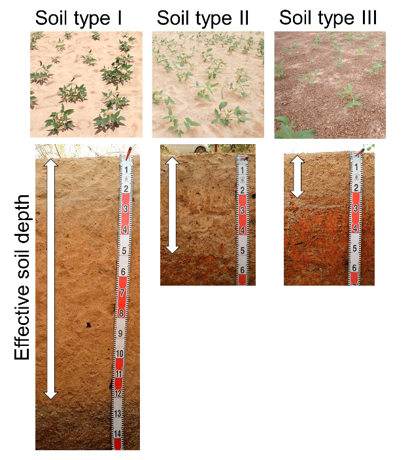Variety selection for improving cowpea production under multi-environmental conditions in the Sudan Savanna
Description
Cowpea (Vigna unguiculata (L.) Walp) is a legume crop widely grown in West Africa. Farmers traditionally cultivate cowpea as a low-cost and high-quality protein source and as a major cash crop. The primary production area is located between 600 and 900 mm yr–1 isohyet, which roughly corresponds to the semi-arid region in the Sudan Savanna. However, the average yield is substantially below the biological potential, and yield vulnerability has been a cause of food insecurity in this region. One of the yield constraints is unstable meteorological conditions, especially low precipitation, causing drought stress. However, the occurrence of agricultural drought is not only determined by precipitation but also by soil type. Therefore, both climate and soil type should be considered in genotype selection and distribution.To identify environmental and plant factors underlying this yield variation and select cowpeas with a stable yield, the grain yield variation of 16 cowpea genotypes in three dominant soils in the Sudan Savanna (Fig. 1) were analyzed in two consecutive years with different precipitation levels. In this study, the three soils were located near each other at the experimental site and thus the meteorological conditions were assumed to be identical for the soil types. The result showed that grain yield was largely different between years even for the same soil type, indicating no single genotype achieved both stable and high yields across these soil types (Fig. 2). In 2016, which had higher precipitation than the average year, variety J showed the highest grain yield across all soil types, while in 2017 with normal precipitation, different varieties showed the highest grain yield depending on the soil type. Based on this result, environment was defined as each combination of year and soil type, and this was subsequently analyzed through an additive main effect and multiplicative interaction (AMMI) model to detect the effects of the environment, genotype, and genotype-environmental interaction (GEI) on grain yield variation. The AMMI model uncovered two cowpea genotypes with stable and higher basal yields across all environments (variety G and variety P in Fig. 3); however, the grain yields of these genotypes were not the highest in each environment. Selection of a genotype with a medium but stable yield would be favorable to improve long-term average yield in the Sudan Savanna, where multiple soils with a large GEI are distributed in mosaic patterns.
The variety selection process employed in this study could be applied also for other regions with different annual precipitation in the Sudan Savanna where the three soil types investigated in this study are widely distributed, although historical cultivation data including sufficient annual rainfall variation is needed for analysis. This method reveals cowpea varieties or genotypes with stable yields for each of the environment and enables increase of cowpea production on a long-term-basis. To further improve cowpea production, appropriate cultivation practices such as fertilizer application and ridge planting may be determined depending on the soil type.
Figure, table
-
Fig. 1. The three predominant soil types in the Sudan Savanna
Each soil type has a different effective soil depth (rooting depth represented by the arrows). Soil type I > type II > type III in terms of soil depth, soil fertility, and water retaining capacity.
-
Fig. 2. Grain yield of the 16 cowpea varieties (A-P) used in this study
Bars are means ± standard deviations for five replications. The arrows indicated the variety of highest grain yield at each of the soil type. Annual precipitation was 999 mm and 795 mm in 2016 and 2017, respectively.
-
Fig. 3. Yield stability of the 16 varieties under the environments defined by the soil types and annual precipitations
The x-axis represents the AMMI stability value. The varieties with lower values have higher yield stability among the environments. The y-axis represents the genetically determined basal yield of each variety. The varieties G and P indicated by the red color have higher stability and higher basal yield at the same time.
- Affiliation
-
Japan International Research Center for Agricultural Sciences Biological Resources and Post-harvest Division
- Classification
-
Research
- Research project
- Program name
- Term of research
-
FY2020(FY2016~FY2020)
- Responsible researcher
-
Iseki Kohtaro ( Biological Resources and Post-harvest Division )
Ikazaki Kenta ( Crop, Livestock and Environment Division )
ORCID ID0000-0001-5460-8570KAKEN Researcher No.: 70582021Batieno Joseph ( Environmental Institute for Agricultural Research, Burkina Faso )
- ほか
- Publication, etc.
-
Iseki K et al. (2021) Field Crops Research, 261:108012https://doi.org/10.1016/j.fcr.2020.108012
- Japanese PDF
-
2020_B04_A4_ja.pdf584.9 KB
2020_B04_A3_ja.pdf584.54 KB
- English PDF
-
2020_B04_A4_en.pdf499.82 KB
2020_B04_A3_en.pdf499.6 KB
- Poster PDF
-
2020_B04_poster.pdf700.28 KB
* Affiliation at the time of implementation of the study.



